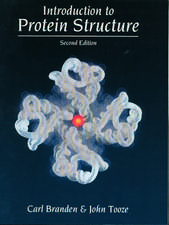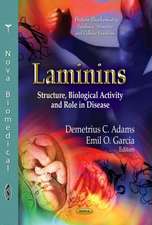Protein Folding Kinetics: Biophysical Methods
Autor Bengt Nöltingen Limba Engleză Paperback – 12 feb 2010
Special features in the second edition:
-Includes detailed information and 12 color figures on the high resolution of folding transition states.
-Discusses structural determinants of the rate of protein folding on a timescale from microseconds to seconds.
-Provides information on self-evolving computer programs for protein-folding simulations and protein-structure predictions.
| Toate formatele și edițiile | Preț | Express |
|---|---|---|
| Paperback (1) | 778.45 lei 6-8 săpt. | |
| Springer Berlin, Heidelberg – 12 feb 2010 | 778.45 lei 6-8 săpt. | |
| Hardback (1) | 646.30 lei 6-8 săpt. | |
| Springer Berlin, Heidelberg – 24 aug 2005 | 646.30 lei 6-8 săpt. |
Preț: 778.45 lei
Preț vechi: 949.33 lei
-18% Nou
Puncte Express: 1168
Preț estimativ în valută:
149.00€ • 161.91$ • 125.24£
149.00€ • 161.91$ • 125.24£
Carte tipărită la comandă
Livrare economică 21 aprilie-05 mai
Preluare comenzi: 021 569.72.76
Specificații
ISBN-13: 9783642066047
ISBN-10: 3642066046
Pagini: 240
Ilustrații: XVI, 222 p. 170 illus., 12 illus. in color.
Dimensiuni: 155 x 235 x 13 mm
Greutate: 0.34 kg
Ediția:Softcover reprint of hardcover 2nd ed. 2006
Editura: Springer Berlin, Heidelberg
Colecția Springer
Locul publicării:Berlin, Heidelberg, Germany
ISBN-10: 3642066046
Pagini: 240
Ilustrații: XVI, 222 p. 170 illus., 12 illus. in color.
Dimensiuni: 155 x 235 x 13 mm
Greutate: 0.34 kg
Ediția:Softcover reprint of hardcover 2nd ed. 2006
Editura: Springer Berlin, Heidelberg
Colecția Springer
Locul publicării:Berlin, Heidelberg, Germany
Public țintă
Professional/practitionerCuprins
Structures of proteins.- Physical interactions that determine the properties of proteins.- Calculation of the kinetic rate constants.- High kinetic resolution of protein folding events.- Kinetic methods for slow reactions.- Resolution of protein structures in solution.- High structural resolution of transient protein conformations.- Experimental problems of the kinetic and structural resolution of reactions that involve proteins.- The folding pathway of a protein (barstar) at the resolution of individual residues from microseconds to seconds.- Highly resolved folding pathways and mechanisms of six proteins.- Structural determinants of the rate of protein folding.- Evolutionary computer programming of protein structure and folding.- Conclusions.
Textul de pe ultima copertă
The book gives a deep insight into the principles and concepts of the kinetic and structural resolution of fast chemical and biophysical reactions of proteins with emphasis on protein-folding reactions. The study of fast protein-folding reactions and the understanding of the folding paradox have significantly advanced due to the recent development of new biophysical methods which allow not only kinetic resolution in the sub-millisecond time scale but also structural resolution with unprecedented precision. Pathways and structures of early and late folding events and the transition state structures of fast- and ultrafast-folding proteins can now be studied in far more detail. Important techniques include biophysical, chemical, molecular biological and mathematical methods, in particular protein engineering, Phi-value analysis, time-resolved circular dichroism, optical triggers and pulsed infrared LASER methods, pressure and temperature jump, ultrafast mixing, stopped flow and quenched flow, dielectric relaxation and electric-field-jump, acoustic relaxation, fluorescence- and isotope-labeling, H/D exchange methods, NMR line broadening and stopped-flow NMR, transition state theory, solutions of rate equations, and evolutionary computer programming. Protein Folding Kinetics - Biophysical Methods is written for students and researchers in biochemistry, biophysics, and related fields.
Special features in the second edition:
• Includes detailed information and 12 color figures on the high resolution of folding transition states.
• Discusses structural determinants of the rate of protein folding on a timescale from microseconds to seconds.
• Provides information on self-evolving computer programs for protein-folding simulations and protein-structure predictions.
Special features in the second edition:
• Includes detailed information and 12 color figures on the high resolution of folding transition states.
• Discusses structural determinants of the rate of protein folding on a timescale from microseconds to seconds.
• Provides information on self-evolving computer programs for protein-folding simulations and protein-structure predictions.
Caracteristici
First methods book which includes many detailed descriptions Absolutely needed and thus timely for the scientific community Comprises 15% more content and includes the special features mentioned Includes supplementary material: sn.pub/extras













